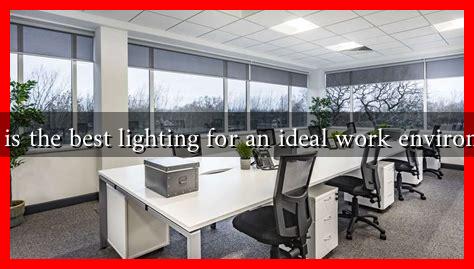-
Table of Contents
What is the Best Lighting for an Ideal Work Environment?
Creating an ideal work environment is crucial for productivity, creativity, and overall employee well-being. One of the most significant factors influencing these aspects is lighting. The right lighting can enhance focus, reduce eye strain, and even improve mood. In this article, we will explore the best types of lighting for a work environment, backed by research and practical examples.
The Importance of Lighting in the Workplace
Lighting is not just about visibility; it plays a vital role in how we feel and perform at work. According to a study by the American Society of Interior Designers, 68% of employees believe that lighting affects their productivity. Furthermore, poor lighting can lead to fatigue, headaches, and decreased morale.
Types of Lighting
Understanding the different types of lighting is essential for creating an ideal work environment. Here are the primary categories:
- Natural Light: Exposure to natural light has been shown to improve mood and energy levels. A study published in the Journal of Clinical Sleep Medicine found that employees with access to natural light reported better sleep quality and overall health.
- Ambient Lighting: This is the general illumination of a space. It should be soft and evenly distributed to avoid harsh shadows. LED ceiling lights are a popular choice for ambient lighting.
- Task Lighting: Task lighting is focused on specific areas where work is performed, such as desks or workstations. Desk lamps with adjustable brightness are ideal for this purpose.
- Accent Lighting: While not essential for work, accent lighting can enhance the aesthetic appeal of a workspace. It can also help create a more inviting atmosphere.
Optimal Lighting Conditions
To create an ideal work environment, consider the following lighting conditions:
- Color Temperature: The color temperature of light is measured in Kelvin (K). For work environments, a color temperature between 4000K and 5000K is recommended. This range mimics natural daylight and helps maintain alertness.
- Brightness Levels: The brightness of the workspace should be adjustable. A general rule of thumb is to have around 300-500 lux for office work. However, areas requiring more focus, like reading or detailed tasks, may need up to 1000 lux.
- Glare Reduction: Glare can be a significant distraction. Use diffusers or shades on windows and choose matte finishes for surfaces to minimize glare.
Case Studies and Real-World Examples
Several companies have successfully implemented optimal lighting strategies to enhance productivity:
- Google: Google’s offices are designed to maximize natural light. Their open spaces feature large windows and skylights, which have been linked to increased employee satisfaction and productivity.
- Steelcase: This office furniture company conducted research showing that employees in well-lit environments reported a 15% increase in productivity. They advocate for a combination of natural and artificial lighting to create a balanced workspace.
Implementing the Right Lighting Solutions
To implement effective lighting solutions in your workspace, consider the following steps:
- Assess Your Space: Evaluate the current lighting conditions and identify areas that need improvement.
- Incorporate Natural Light: If possible, arrange workstations near windows or use light tubes to bring natural light into darker areas.
- Invest in Quality Fixtures: Choose energy-efficient LED lights that offer adjustable brightness and color temperature settings.
- Encourage Employee Feedback: Regularly solicit feedback from employees about their lighting preferences and make adjustments as needed.
Conclusion
In conclusion, the best lighting for an ideal work environment is a combination of natural and artificial light that meets the specific needs of the workspace. By understanding the different types of lighting, optimal conditions, and real-world examples, employers can create a more productive and enjoyable work atmosphere. Remember, investing in quality lighting is not just about aesthetics; it’s about enhancing employee well-being and performance. For more insights on workplace design, you can visit the American Society of Interior Designers.


